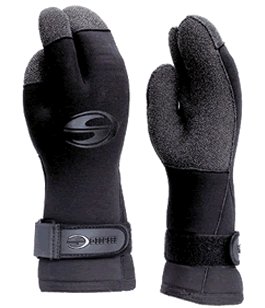Hood, Gloves & Boots

Diving gloves should be close-fitting, with long, gusseted, zippered, or Velcro gauntlets that overlap your suit sleeves. This is especially important with a drysuit, since the glove will protect the delicate wrist seal on the suit. Thin tropical gloves are of very limited use in the north - your gloves should be at least 5mm thick. Three-fingered mitts are much warmer than five-fingered gloves and are really not much clumsier. They are also much easier to get on and off, which makes me wonder why so few people use them. A little spray soap will make any glove easier to get on.
A hood is critical for maintaining warmth in the water. A good hood will be as close-fitting as possible, and have a generous collar for tucking into your wetsuit, thin skin-in seal around the face, and baffled vents in the top to release bubbles. A neck skirt is much less necessary with a drysuit, but it is a simple matter to cut one off if you don't like it. A neoprene cold-water hood should be at least 5-6mm thick.
The face-hole of a hood should be as small as possible - there is no reason to expose any skin here. The face seal of the hood should overlap your mask skirt, with just barely enough room below for your regulator. You can always trim out a too-small face-hole, but a too-big one pretty much negates any other good qualities a hood may have. Ideally, with mask and hood on, you should expose a small patch on each cheek, and no more.
An alternative for drysuit divers is the attached dry hood. This is usually made of thin latex, and depends on a dry insulating cap underneath for warmth. When it's really cold, go ahead and wear two hoods.
Whatever glove design you use, make sure it has a tough, abrasion-resistant material on the palms and high-wear areas. The best I have seen is Kevlar, but most have some kind of pattern of little plastic dots, like gardening gloves. These quickly wear off, leading to the premature demise of the glove. To extend their life, get an inexpensive can of neoprene cement from your local dive shop, and paint the palms of your gloves with a layer of it ( not Kevlar ones, though. ) Do this when the gloves are new, and repeat as necessary. You can also cement to repair the inevitable nicks and cuts that will occur.

Drysuit divers also have the option of using dry gloves. Similar to a dry hood, the dry glove extends your drysuit seal around your hands. These gloves are usually a thin rubber material, and if you tear it you can flood your whole suit, which is why I would not recommend them.
Wetsuit divers will require boots to go along with their suits. Again, a minimum of 5mm thick, with long fully gusseted zippers. If you plan to do a lot of shore diving, a heavy shoe-like sole may be useful, otherwise, there is no need to spend a great deal of money on boots. A common newbie mistake is to wear your boots outside your suit. This way, they balloon as you swim, and are worse than worthless. Always tuck your boots inside your wetsuit legs for best effect. Of course, drysuit divers don't need boots - they're built-in. But you may still want a pair to make your fins fit in the tropics.
Some people claim that wearing socks inside your boots keeps you warmer. I don't see how. Add a short piece of shoelace or reel line to all your zipper pulls, and it will be much easier to work them. Just knot it at both ends, don't make a snag-prone loop.
